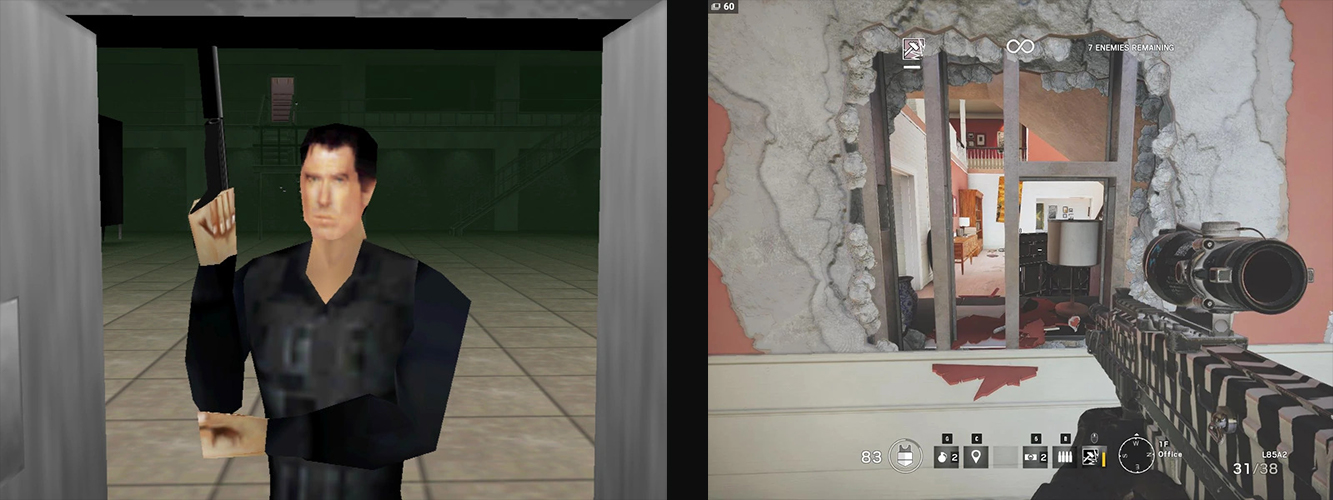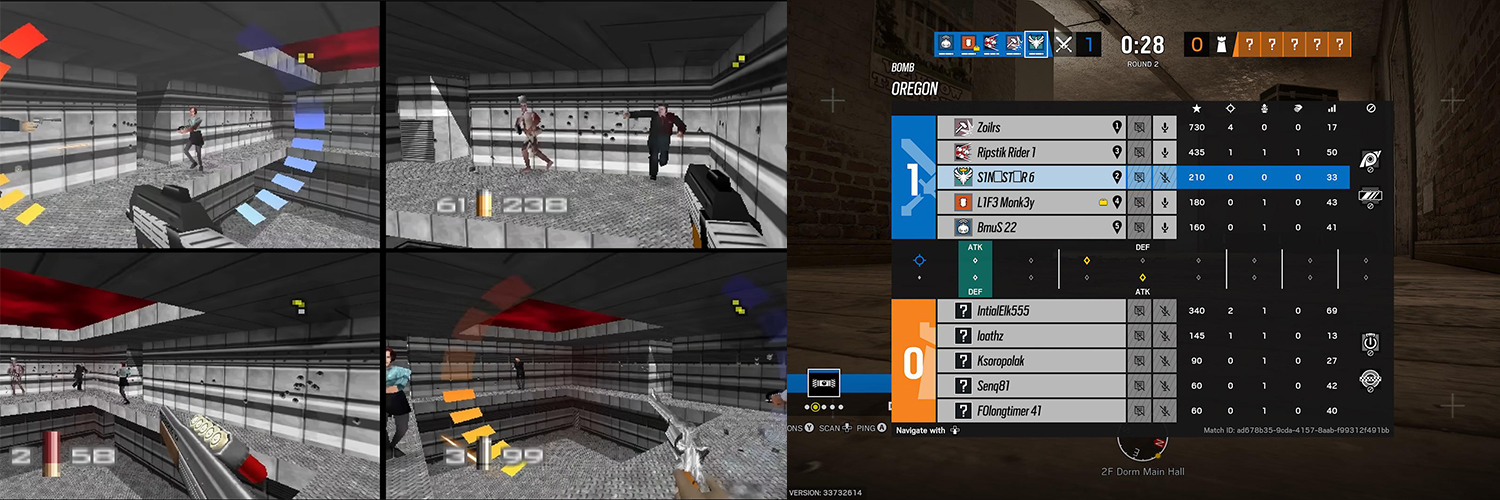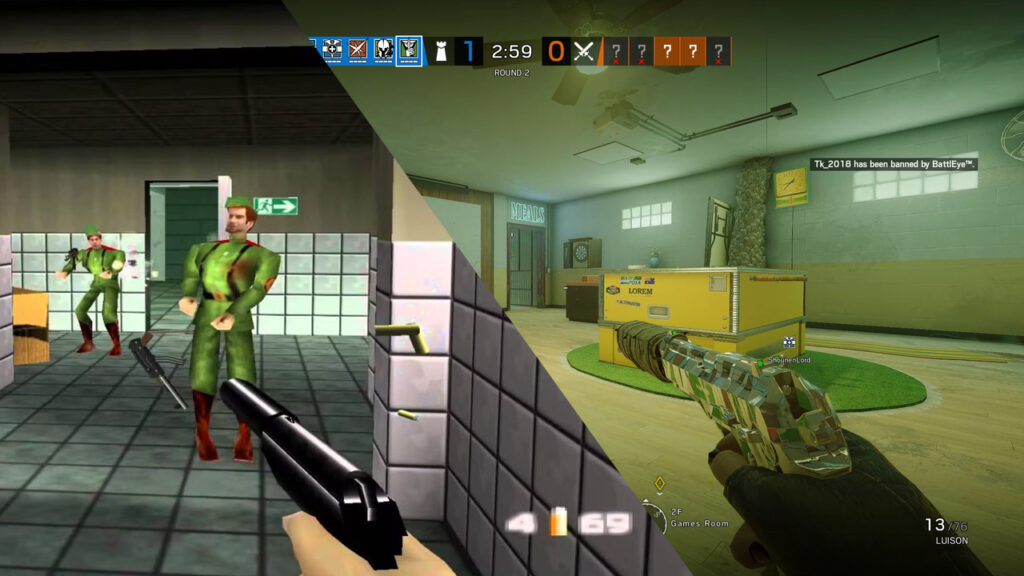First-person shooters (FPS) have come a long way since the days of pixelated spies and questionable hitboxes. From the couch-coop chaos of GoldenEye 007 to the high-stakes, hyper-tactical tension of Rainbow Six Siege, the genre has evolved faster than a speed runner completing Facility on 00 Agent. But let’s be honest: whether you’re a nostalgic ’90s kid or a modern tactical mastermind, there’s a special place in your heart for both eras of FPS gaming. So, grab your N64 controller or your RGB-lit keyboard, and let’s take a warm, slightly humorous trip down memory lane—and into the future.
Graphics and Immersion: From Blocky Bonds to Breachable Walls

GoldenEye 007:
Ah, GoldenEye. The game that made us believe that Pierce Brosnan was made entirely of rectangular pixels. For its time, the graphics were mind-blowing. Sure, by today’s standards, the characters look like they were assembled out of Lego bricks, but back then, we didn’t care. We were too busy being immersed in the thrill of sneaking through the archives or sniping from the cradle. And let’s not forget the split-screen multiplayer, where friendships were tested over who got to play as Oddjob (cheaters, all of you).
Rainbow Six Siege:
Fast forward to Siege, and the graphics are so realistic you can practically smell the gunpowder. The environments are meticulously detailed, the lighting is moodier than a teenager’s playlist, and the destructible walls mean you can finally live out your dream of being a one-person demolition crew. But let’s be real: no matter how pretty the game looks, nothing will ever match the sheer joy of watching your friend’s pixelated face contort in agony after you stick them with a proximity mine in GoldenEye.
Gameplay and Mechanics: From “Shoot Everything” to “Shoot Everything, But Strategically”
GoldenEye 007:
The gameplay in GoldenEye was gloriously simple. Move with one stick, aim with auto-assist (because let’s face it, we needed it), and shoot anything that moved. The campaign was a mix of stealth and chaos, and the multiplayer was pure, unadulterated fun. Who needed tactics when you had the Golden Gun and a dream? The only real strategy was deciding whether to play as Jaws or Baron Samedi and then arguing about it for 20 minutes.
Rainbow Six Siege:
Siege, on the other hand, is like playing chess if every piece had a gun and a bad attitude. The game demands precision, teamwork, and a willingness to accept that you will die—a lot. Operators have unique abilities, which means you can’t just run in guns blazing (unless you’re playing as Ash, in which case, go nuts). The destructible environments add a layer of strategy that GoldenEye could only dream of, but let’s be honest: sometimes you just miss the simplicity of slapping your friends to death in a pixelated bathroom.
Multiplayer Experience: From Couch Chaos to Online Anarchy

GoldenEye 007:
The multiplayer in GoldenEye was the stuff of legends. Four players, one CRT TV, and a whole lot of shouting. The split-screen mode was the ultimate social experience, even if it meant squinting at a quarter of the screen to figure out where you were. The game modes were simple but endlessly entertaining, from “Slappers Only” (the purest form of combat) to “Proximity Mines” (the purest form of chaos). It was a time when the only lag was caused by someone accidentally kicking the console.
Rainbow Six Siege:
Siege’s multiplayer is a whole different beast. Gone are the days of couch-side trash talk (unless you count yelling into a headset). Instead, you’re teamed up with strangers from around the world, all of whom have very strong opinions about how you should be playing. The 5v5 matches are intense, strategic, and occasionally rage-inducing. And while the lack of split-screen is a bummer, the thrill of pulling off a perfectly timed breach or clutch defuse is unmatched. Just don’t forget to mute the guy screaming in your ear about how you should’ve picked Thermite.
Cultural Impact and Legacy: From Nostalgia to Esports
GoldenEye 007:
GoldenEye didn’t just popularize FPS games on consoles—it defined a generation. It was the game that made us believe that movie tie-ins could actually be good (a belief that was quickly shattered by Enter the Matrix). Its influence can still be felt today, from the countless memes about Oddjob’s unfair height advantage to the endless debates about whether the Facility map is the greatest of all time (it is).
Rainbow Six Siege:
Siege represents the modern era of gaming, where live-service models and esports reign supreme. The game has become a cultural phenomenon in its own right, with a dedicated fanbase and a thriving competitive scene. It’s also proof that games can evolve over time, with regular updates keeping the experience fresh. But no matter how many new operators or maps are added, nothing will ever top the sheer joy of playing GoldenEye for the first time and realizing that video games could be this much fun.

Accessibility vs. Complexity: From “Pick Up and Play” to “Pick Up, Die, and Watch Tutorials”
GoldenEye 007:
One of GoldenEye’s greatest strengths was its accessibility. You didn’t need to be a gaming prodigy to enjoy it—just a willingness to have fun. The controls were simple, the mechanics were straightforward, and the only thing standing between you and victory was your friend’s ability to camp in the perfect spot with the RCP-90.
Rainbow Six Siege:
Siege, on the other hand, is not for the faint of heart. The learning curve is steeper than a ladder on the Skyscraper map, and the game’s reliance on teamwork means you’ll need to communicate effectively (or at least pretend to). But for those who stick with it, the rewards are immense. There’s nothing quite like the feeling of outsmarting your opponents with a perfectly executed strategy—or, failing that, accidentally blowing a hole in the wall and creating a new path to victory.
Conclusion: Two Eras, Two Masterpieces, and One Big Question
So, which is better: GoldenEye 007 or Rainbow Six Siege? The answer, of course, is both. GoldenEye is the beloved grandparent of modern FPS games, a reminder of simpler times when all you needed for a good time was a CRT TV and a few friends. Siege is the ambitious grandchild, pushing the genre forward with its tactical depth and modern innovations.
At the end of the day, whether you’re a fan of the blocky nostalgia of GoldenEye or the high-stakes intensity of Siege, one thing is clear: FPS games have come a long way, and we’re all just along for the ride. Now, if you’ll excuse me, I have a date with a proximity mine and a pixelated Oddjob. See you on the battlefield—or the Facility.
